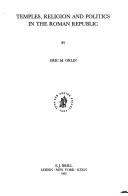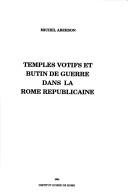| Listing 1 - 10 of 44 | << page >> |
Sort by
|
Book
ISBN: 3774930317 Year: 2002 Publisher: Bonn Habelt
Abstract | Keywords | Export | Availability | Bookmark
 Loading...
Loading...Choose an application
- Reference Manager
- EndNote
- RefWorks (Direct export to RefWorks)
Book
ISBN: 3110049899 3110049902 9783110049893 9783110049909 Year: 1978 Volume: 5 Publisher: Berlin de Gruyter
Abstract | Keywords | Export | Availability | Bookmark
 Loading...
Loading...Choose an application
- Reference Manager
- EndNote
- RefWorks (Direct export to RefWorks)
Temples --- Temples, Roman --- Temples romains
Book
ISBN: 1316795713 110717421X 1107162548 9781107174214 9781107162549 9781107162471 Year: 2018 Publisher: New York : Cambridge University Press,
Abstract | Keywords | Export | Availability | Bookmark
 Loading...
Loading...Choose an application
- Reference Manager
- EndNote
- RefWorks (Direct export to RefWorks)
In this magisterial two-volume book, Pier Luigi Tucci offers a comprehensive examination of one of the key complexes of Ancient Rome, the Temple of Peace. Based on archival research and an architectural survey, his research sheds new light on the medieval, Renaissance, and Baroque transformations of the basilica, and the later restorations of the complex. Volume 1 focuses on the foundation of the complex under Vespasian until its restoration under Septimius Severus and challenges the accepted views about the ancient building. Volume 2 begins with the remodelling of the library hall and the construction of the rotunda complex, and examines the dedication of the Christian Basilica of SS Cosmas and Damian. Of interest to scholars in a range of topics, The Temple of Peace in Rome crosses the boundaries between classics, archaeology, history of architecture, and art history, through Late Antiquity, the Middle Ages, and the early modern period.
Temples, Roman --- Architecture, Roman --- Roman temples --- Temple of Peace (Rome, Italy) --- Temples, Roman - Italy - Rome --- Architecture - Rome - History --- Forum Pacis (Rome, Italy) --- Rome - Antiquities --- Architecture --- History. --- Rome --- Antiquities
Book
ISBN: 9782503588353 2503588352 Year: 2020 Volume: 10 Publisher: Turnhout : Brepols,
Abstract | Keywords | Export | Availability | Bookmark
 Loading...
Loading...Choose an application
- Reference Manager
- EndNote
- RefWorks (Direct export to RefWorks)
Was geschah in der Stadt Rom mit den republikanischen Tempelbauten während der Kaiserzeit? Wie wurden diese (noch) genutzt? Welchen baulichen Veränderungen unterlagen sie? Neue Akteure, veränderte Machtverhältnisse, eine ganze Stadt im Wandel, zunehmend begrenzter Raum, wegfallende Sichtachsen, letztendlich aber auch neue Kulte sowie neue Formen von Kultbauten und -praktiken bestimmen den Rahmen, vor dem auch das Fortbestehen der bereits in republikanischer Zeit vorhandenen Heiligtümer betrachtet werden muss. Dabei zeichnet sich ein Bild ihrer Nutzungsweisen und Funktionen, das kaum heterogener sein könnte, sich bei näherer Betrachtung jedoch sinnvoll zu einem Ganzen verbindet. Geprägt von Pragmatismus und dem Repräsentationswillen verschiedener Akteure spiegelt sich im unterschiedlichen Umgang mit den Heiligtümern die räumliche und funktionale Segmentierung der kaiserzeitlichen Stadt eindrucksvoll wider. Dabei steht weit mehr als die Rekonstruktion der bisher häufig vernachlässigten kaiserzeitlichen Phasen ausgewählter Heiligtümer im Vordergrund. Es sind die Einbettung der Architekturen und Räume dieser Stätten in das urbane Umfeld, die Konzeption städtischen Raumes und insbesondere auch die Frage, welche Rolle den ‚alten‘ Kulten in einer ‚neuen‘ Stadt beigemessen wurde, die das Augenmerk dieses Buches bilden.
Temples, Roman --- Rome --- Rome --- Rome --- Rome --- History --- History --- Religious life and customs --- Buildings, structures, etc.
Book
ISBN: 888500783X Year: 1985 Publisher: Roma Bretschneider
Abstract | Keywords | Export | Availability | Bookmark
 Loading...
Loading...Choose an application
- Reference Manager
- EndNote
- RefWorks (Direct export to RefWorks)
Classical antiquities --- Temples, Greek --- Temples, Roman --- Augustus, --- Cult. --- Rome --- Religious life and customs.

ISBN: 8878131954 Year: 1989 Publisher: Roma De Luca
Abstract | Keywords | Export | Availability | Bookmark
 Loading...
Loading...Choose an application
- Reference Manager
- EndNote
- RefWorks (Direct export to RefWorks)
Bridges --- Temples, Roman --- Votive offerings --- Foundations and piers --- Catalogs --- Ponte di Nona Site (Italy) --- Catalogs.
Book
ISBN: 8475805388 9788475805382 Year: 1988 Publisher: Sevilla Monte de Piedad y Caja de Ahorros de Sevilla
Abstract | Keywords | Export | Availability | Bookmark
 Loading...
Loading...Choose an application
- Reference Manager
- EndNote
- RefWorks (Direct export to RefWorks)
Temples, Roman --- Italica (Extinct city) --- Spain --- Seville (Spain : Province) --- Buildings, structures, etc. --- Antiquities, Roman. --- Antiquities, Roman.

ISBN: 9004107088 9004329897 9789004107083 Year: 1997 Volume: 164 Publisher: Leiden Brill
Abstract | Keywords | Export | Availability | Bookmark
 Loading...
Loading...Choose an application
- Reference Manager
- EndNote
- RefWorks (Direct export to RefWorks)
A study of the construction of new temples in the Roman Republic, a process which illuminates key features of both their political and religious systems. It offers an analysis of the relationship between the individual and the community, both human and divine, and their responsibilities toward one another. The book examines in detail each of the three main stages in the construction of a new temple: the vow, the placing of a contract, and the dedication. Special attention is paid to the ability of a Roman magistrate to enter into building obligations on behalf of the state, and the role of the general's share of the spoils of war, his manubiae. In contrast to previous studies, this work emphasizes the significant role played by the Roman Senate, and thus offers a new interpretation of the symbolic meaning of this process. This publication has also been published in paperback, please click here for details.
Roman history --- Temples, Roman. --- Religion and politics --- Temples romains --- Religion et politique --- Religious life and customs. --- Vie religieuse --- Temples, Roman --- Temple --- --Rome ancienne --- --Religion --- --Politique --- --Religion and politics --- -Temples, Roman --- 292.07 --- Roman temples --- Politics and religion --- Religion Classical Roman --- --Comparative religion --- Comparative religion --- Political science --- Politics, Practical --- Religion --- Religions --- Religious aspects --- Political aspects --- Rome --- --Temples, Roman. --- Religion and politics. --- Religion and politics - Rome --- Rome ancienne --- Politique
Book
ISBN: 9782870312766 2870312768 Year: 2012 Volume: 335 Publisher: Bruxelles Latomus
Abstract | Keywords | Export | Availability | Bookmark
 Loading...
Loading...Choose an application
- Reference Manager
- EndNote
- RefWorks (Direct export to RefWorks)
Temples, Roman --- Shrines --- Temples romains --- Sanctuaires --- Rome --- Religion. --- Religion --- Temples --- Civilization --- Sacred space --- Architecture --- Church architecture --- Religious institutions --- Roman temples --- Holy places --- Places, Sacred --- Sacred places --- Sacred sites --- Sacred spaces --- Sites, Sacred --- Space, Sacred --- Holy, The --- Religion and geography --- Civilization. --- Italy [Northern ] --- Alps Region --- Temples [Roman ] --- Temples - Italy, Northern --- Temples - Alps Region --- Temples, Roman - Italy, Northern --- Rome - Religion --- Rome - Civilization --- Religious architecture

ISBN: 9780121141943 8871400666 3805313993 9783805313995 9788871400662 Year: 1984 Volume: 26 Publisher: Rome : Genève : Mainz : Institut suisse de Rome ; Droz ; P. von Zabern,
Abstract | Keywords | Export | Availability | Bookmark
 Loading...
Loading...Choose an application
- Reference Manager
- EndNote
- RefWorks (Direct export to RefWorks)
Temples, Roman --- Inscriptions, Latin --- Manubiae (le mot latin) --- Temples romains --- Mécénat --- Voeux --- Butin de guerre --- -Temples, Roman --- -Roman temples --- Latin inscriptions --- Roman temples --- Latin language --- Latin philology --- Temples romains. --- Voeux de religion --- Temples, Roman - Italy - Rome. --- Inscriptions, Latin - Italy - Rome. --- Mécénat
| Listing 1 - 10 of 44 | << page >> |
Sort by
|

 Search
Search Feedback
Feedback About UniCat
About UniCat  Help
Help News
News